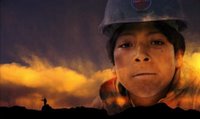The devil's miner

Just bought myself this movie and wanted to talk about it. I don't want to review it, I am not a movie critic, but just post some thoughts.
The event remembers the celebrated father Romero and among many talks, discussions, workshops, presentations, etc., this movie is being shown. So I looked it up on the net and found plenty of info (www.thedevilsminer.com)
As I read the various descriptions and reviews I became more interested and finally decided to watch the film.The movie is a documentary about the lives of two young child miners from Potosi, Bolivia. The older brother is Basilio and is 14 years old, and the younger brother's name is Bernardino, aged 12. It was shot by the Austrian film maker Richard Ladkani and his American partner Kief Davidson. The two were filming and working for seven years to bring this project to realization.The film is very well made, in my opinion. The film makers try and succeed on showing the world of Basilio and Bernardino from the point of view of the children. This brings even more to the foreground the reality in which the two live. A world of extreme poverty, much harder than many of us could imagine and to top it all off, with out a father who could alleviate their lives in some meaningful way.The film also shows a world full of religious contradictions in which the Bolivian miners have lived for centuries. A world in which while outside of the mine, the people believe in God and Jesus. But, once they venture into the tunnels underneath the earth, they have to believe and worship the devil or as they call it the "uncle of the mine" (in Spanish, tio de la mina). This apparent blasphemy is entirely explainable and non-contradictory in that world. When the miners are in the realm of God, i.e. outside of the mines, they believe God is watching after them. Once the miners enter the realm of the devil, i.e. the caverns, they believe the devil will watch after them. This belief, I assume is kind of practical. Since the mines are the realms of the devil, they pay tribute to the lord of the place. The miners recognize that the devil can take their lives away any time and therefore they have to respect him.What impressed me more about the movie was the way Basilio took his new role as "the bread winner" of the household with so much ease. He could be, a father, a brother, a son and child, all at once. When going to work, he would take his younger brother, Bernardino, to help him at work. There he would watch out after him and would also take time to train him and ease him into the work. At home, he would play with his siblings (he also had a much younger sister) like a child. Another thing that impressed me was how conscious of their mortality the two kids were. They knew that if they continued working in the mines it would mean a short life. However, they accepted this as part of the life of a miner. The film really showed the hard life of a miner through the eyes of a child miner. And how is the reality of child labor in modern Bolivia. It is a film to see and to think about it afterwards. One cannot help but to think about it. For what it's worth, I really recommend seeing the movie. The only thing I didn't like is that too many of the scenes were filmed with a hand held camera. So you get those shots where the image is moving and you can get sick if you watch it too intensly. Thise scenes did not let me concentrate on the film. But, the film is well worth the watch. Enjoy it.



0 Comments:
Post a Comment
<< Home